




placename:-
"... this terrible aspect of the hills, when having passed Kendal, ..."
placename:- Birbeck Fells
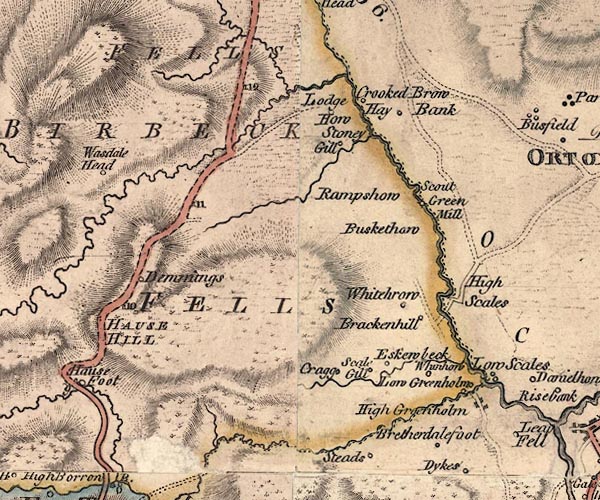
J5NY50NE.jpg
"BIRBECK FELLS"
area
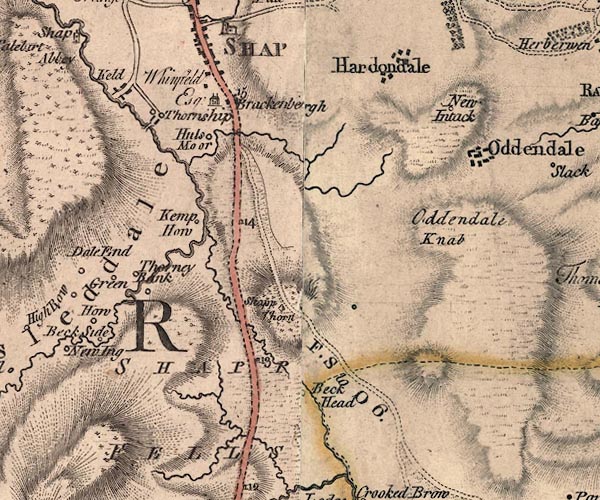
J5NY51SE.jpg
"SHAPP FELLS"
hill hachuring; hill or mountain
item:- National Library of Scotland : EME.s.47
Images © National Library of Scotland
 goto source
goto sourcePage 174:- "[Shap Fells] a dreary, melancholy tract of twelve miles [1]. ..."
"[1] This elevated tract being near the centre of Westmorland, and where we may suppose its Genius is most likely to sit enthroned, it may afford the reader a seasonable amusement to peruse in this place a little ode, addressed to that imaginary being, by a late elegant bard, when on one of his visits to his native country."
"ODE"
"To the Genius of Westmorland."
"Hail, hidden Power of these wild groves, / These uncouth rocks and mountains grey; / Where oft, as fades the closing day, / The family of fancy roves."
"In what lone cave, what secret cell, / Coeval with the birth of time, / Wrapt in high cares, and thought sublime, / In awful silence dost thou dwell!"
"Oft in the depth of winter's reign, / As blew the dark winds o'er the dale, / Moaning along the distant gale, / Has fancy heard thy voice complain."
"Oft in the dark wood's lonely way, / Swift has she seen thee glancing by; / Or down the summer evening sky, / Sporting in clouds of gilded day."
"I caught from thee the sacred fire, / That glow'd within my youthful breast;- / Those thoughts too high to be express'd, / Genius, if thou didst once inspire."
"O! pleas'd, accept this votive lay, / That in my native shade retir'd, / And once, once more by thee inspir'd, / In gratitude I pay."
"Langhorne's Effusions of Friendship and Fancy Vol.1, Let.25. X."
placename:- Shapfells
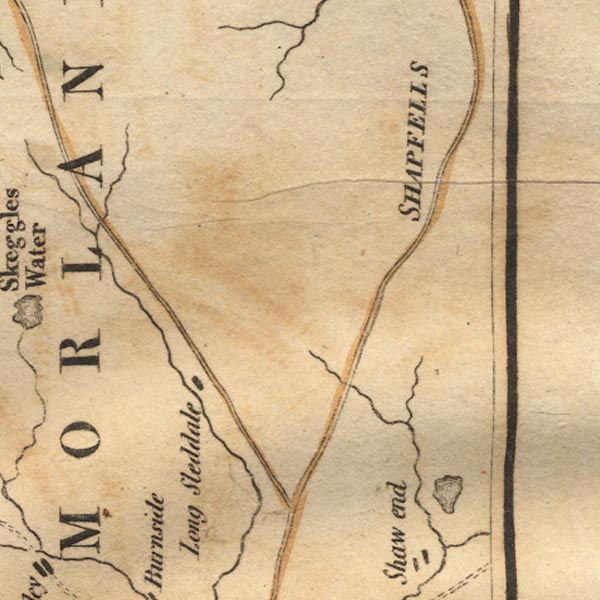
Ws02NY50.jpg
"SHAPFELLS"
item:- Armitt Library : A1221.1
Image © see bottom of page
placename:- Shap Fells
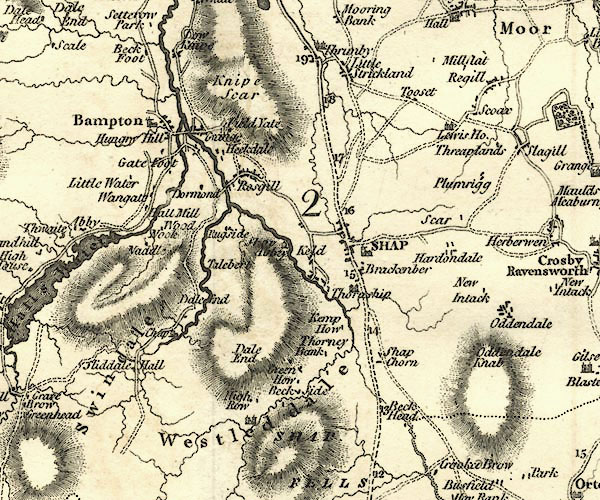
CY24NY51.jpg
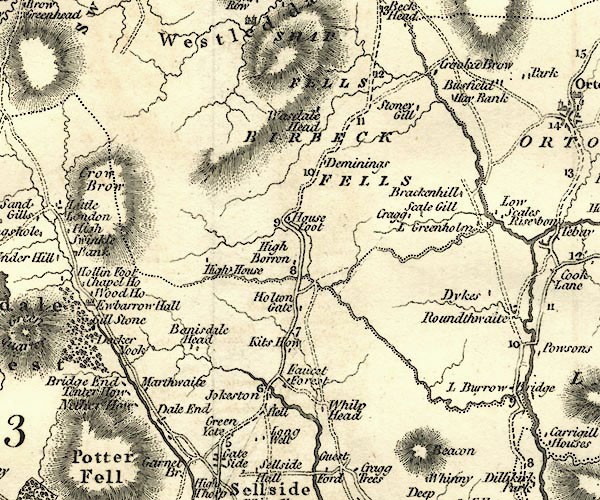
CY24NY50.jpg
"SHAP FELLS"
hill hachuring
item:- JandMN : 129
Image © see bottom of page
item:- geology; glacial erratic
 goto source
goto sourcePage 151:- "... Another variety of granite with reddish felspar in large crystals, is found on Shap Fells, and may be observed in situ on the road side near Wasdale Bridge, about four miles south of Shap."
"..."
 goto source
goto sourcePage 161:- "A superincumbent bed of limestone, by some called the mountain, by others the upper transition limestone, mantles round these mountains, in a position unconformable to the strata of the slaty and other rocks upon which it reposes. It bassets out near ... Dacre, Lowther and Shap; ..."
"..."
Page 163:- "Bowlder stones are often met with, far removed from their native rock, but do not appear to have been carried over high mountain ridges. The granite blocks from Shap Fells are carried over a great part of Westmorland; but are not found in the"
 goto source
goto sourcePage 164:- "neighbourhood of the lakes. ..."
placename:- Shap Fells
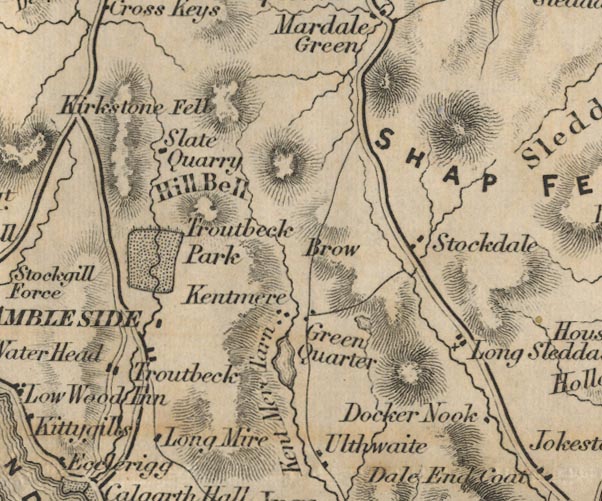
FD02NY40.jpg
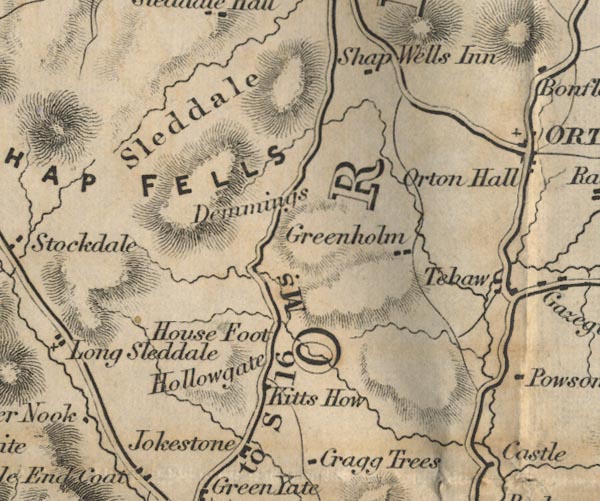
FD02NY50.jpg
"SHAP FELLS"
Hill hachuring.
item:- JandMN : 100.1
Image © see bottom of page
placename:- Shap Fells

FD02NY40.jpg

FD02NY50.jpg
"SHAP FELLS"
Hill hachuring.
item:- JandMN : 100.1
Image © see bottom of page
placename:- Shap Fells
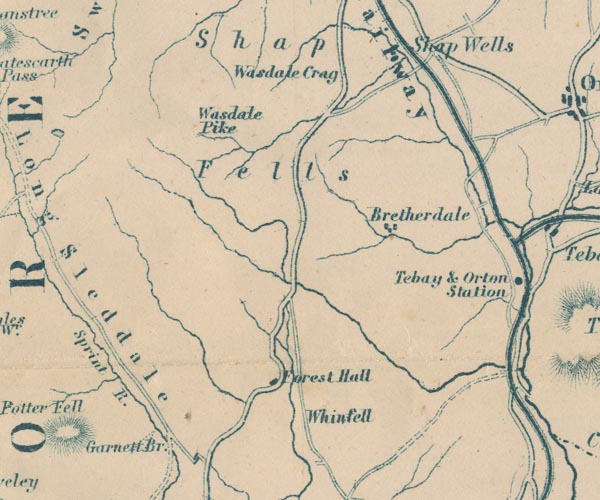
GAR2NY50.jpg
"Shap Fells"
area
item:- JandMN : 82.1
Image © see bottom of page
placename:-
"... This is some of the loneliest country in England, a rare place for deep snowdrifts even in winters that are mild elsewhere. The road climbs Shap Fell to a height of 1,400 feet, with a bog at the top and then a descent to Shap village. This district is the place of origin of those great boulders of Shap granite whose presence in widely separated parts of England affords one of the most striking evidences of the glacial epoch of the dim past. Ages before man lived in Britain great glaciers ground their incredible way across the primeval landscape, rolling along with them detached fragments of the rocky mountains whose ultimate shape they helped to fashion. Passengers up the Great North Road may see one of these boulders of Shap granite at Thirsk in North Yorkshire, sixty miles from Shap as the crow flies, and goodness knows how many more miles by the devious ways of glaciers. The name of Shap is famous in English geology. ..."
placename:- Shap Fells
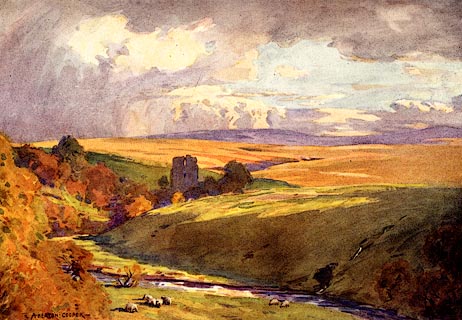 click to enlarge
click to enlargeMB0107.jpg
Tipped in opposite p.32 in Wild Lakeland by MacKenzie MacBride.
printed at bottom:- "SHAP ABBEY AND FELLS"
signed at lower left:- "A. HEATON COOPER"
item:- JandMN : 195.9
Image © see bottom of page
